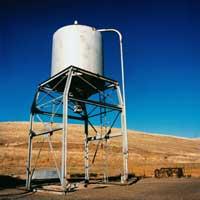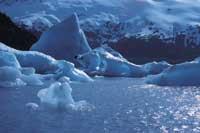Underground liquid treasure
From space, the Earth looks blue, a blue planet full of water, as water is the most abundant substance on the Earth's surface. To unite all this water we would need a container of about 1500 million cubic kilometers, but if instead of adding, we classify the water of the planet, we obtain very different results: Of about 1,500 cubic kilometers, most water is non-potable water, 97.2% of the water is oceanic and marine, therefore, salty. Fresh water only accounts for 2.8% of the volume and, again, the numbers do not tell the whole truth, since 2.8% is not accessible.

Fresh water is a very scarce resource and to realize it you only have to do the following exercise: take the container of a liter and consider that all the water of the soil is a liter. Then, as the water is classified (water is being classified as a resource), the bottle is gradually emptied. As mentioned, 97.2% of the water is saltwater, so 972 ml outdoors. In the bottle we will stay 128 ml, but not all that water is liquid. 76% of fresh water is in solid state, frozen, trapped in glaciers, poles and high mountain peaks, and although sweet, it is not useful. Returning to the example bottle, 98 ml more outside. In the end we have left 30 ml of water in the bottle, 30 ml of water to quench the thirst of 6.000.000 million inhabitants. Little, right?
Dispersed resource
These 30 ml bottles are also not equally distributed geographically or equally. However, rivers and lakes are not our main freshwater reservoirs, as lakes and rivers account for only 0.3% of freshwater. The largest reserves of fresh water are not found in the areas we can see, but in the subsoil, which is 0.62% of the aforementioned 2.8%, or what is the same, 95% of the available water. That is, 28.5 of the 30 ml forgotten in the bottle. Most of the water we can use to drink, wash clothes, for industry or for agriculture is underground. In the deserts they have lived for thousands of years thanks to groundwater reserves. In some places, groundwater is the only important and often unique source of food for plants that will feed man and animals. But groundwater is not only a thing of countries with dry bark, it is also an indispensable resource for a quarter of the Canadian population, full of lakes, rivers and waterfalls.
When we talk about groundwater, the current of water that is poured to tens of meters of depth and the lake sunk between the rocks are perhaps the first images that come to mind. But groundwater does not accumulate as on the surface in rivers and lakes, at least not always. On the contrary, water is everywhere on the ground.
In the cracks and fissures between rocks and clay particles, in the cracks and fissures of the rocks, the water accumulated in all these holes is also groundwater, better said, groundwater.

The largest volume of water is concentrated at 100 meters below which the lagoons are much smaller. The water is slowly poured under the ground, from one level to another, from one depth to another, and many times the discharges of multiple origin are collected in wells, aquifers. The water of the latter is what we obtain by pump.
Sustainable sources of pollution
Groundwater is dynamic, moving and part of the hydrological cycle. But in the ground the water moves slowly. The time it takes for water in the subsoil is not always the same, but in general it is long. The stay will sometimes be a few days, several weeks in others and several thousand years. Land stays over 10.00 years are not exceptional. River water is completely renewed in two weeks. Due to the long duration of the stay, the pollution problems of the aquifers are more serious than those of the rivers: the aquifers act as giant sponges that absorb the pollution and keep the pollution absorbed for a long time. Cleaning the contaminated aquifer is not easy, but if it is not cleaned it can become a source of contamination at eleven years.
Humans have polluted most aquifers in a very short time, specifically in the last 40 years. Today, pollution and abuse are the urgent problems to be solved, but the mechanisms put in place to address these problems are very slow. A few years ago, in addition, awareness of the problems of aquifers was aroused, since these are not seen and there is no problem that is not seen. However, the countries of the world have gradually discovered the importance of this resource and some governments have modified and adapted the laws to protect groundwater.

Since 1900 water is used six times before in the world, but water management does not improve six times. Nowadays, we often use water as if it were exhaustion. If so, critical reductions can occur in the amount of water available over the next 50 years, as the amount available per person will be halved by 2025. And the amount is already reduced: today we only have half of what they had available in 1960.
Apart from polar ice, groundwater is 95% of the fresh water we have. Most surface rivers and lakes have long been used, often with mishandled use. And while rivers manage well, the water they provide is not enough to meet the needs of the world's population
... Without a doubt, groundwater is a resource of great future that will supply a growing population. Looking ahead, desalination of sea water could be another way to obtain water for consumption, although it is not yet too expensive and viable.
Main problems of aquifers
- Abuse: water from aquifers is renewed very slowly, but in many countries the water renewal factor is not taken into account. As a result, many aquifers are drying up. Many of the aquifers that are drying up can hardly be recovered, as they are in arid or semi-dry areas today. It is estimated that the emptying time of these aquifers would be less than 50 or 100 years.
- Chemical pollution: Herbicides, fertilizers and polluting chemicals used in the industry reach aquifers through the soil and can be sources of contamination in the subsoil for hundreds or thousands of years.
- Salting: salting is a problem of many coastal aquifers. If the aquifer level drops below sea level, sea water can penetrate inland, destroying the aquifer.
- Discharges in underground pipelines: urban or industrial waste transport pipes, oil pumping pipes, etc... the possible discharges of this type of structures are a source of very dangerous contamination of aquifers.
- National borders: aquifers located on international physical borders can cause conflicts and tensions between peoples.
Ancient knowledge for aquifer recoveryThe rainwater collection tank has been for thousands of years the fundamental tool of each home and family, since it extracted all the water that was for the home. Formerly, every house had its own deposit. Modern water pumping technology from aquifers has made rainwater collection tanks obsolete. But the facilities of modern technology have led many aquifers to desiccation and, therefore, with the help of NGOs, have launched initiatives in Indian villages to recover the "archaic" technology of their ancestors. In the western regions some 30o thousand wells have been renovated and equipped with rainwater collection mechanisms. In addition, thousands of small reservoirs and other systems have been launched, initiatives that have allowed the water level of the aquifers of western India to rise dramatically. South India has redesigned 200,000 irrigation tanks. These tanks, fed for hundreds of years from the aquifers, have been installed so that they can be fed from other sources of faster renovation. The results of the project have also been very satisfactory, as aquifers have reflooded and dried springs and streams have risen. Such initiatives have developed not only in agricultural areas and villages but also in larger cities. In 1997, 1,500 new homes equipped with cisterns were built in eastern India. |
Published in the supplement Natura de Gara
Buletina
Bidali zure helbide elektronikoa eta jaso asteroko buletina zure sarrera-ontzian











